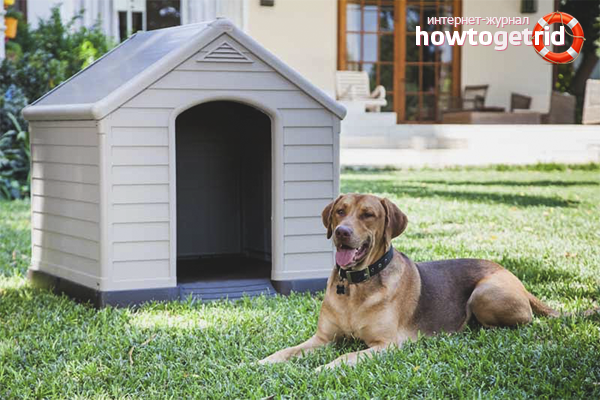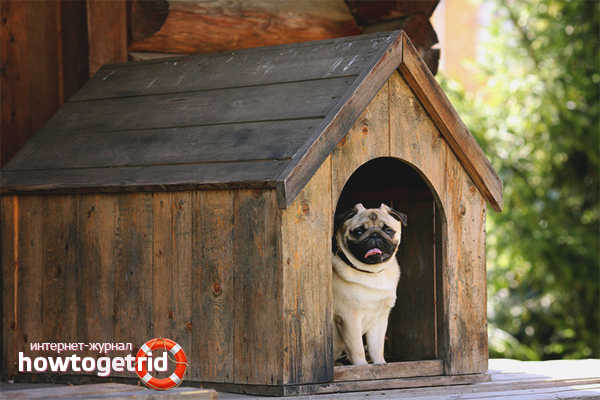The content of the article
Newly made dog owners strive for impeccable discipline in terms of raising pets, which are brought in to protect the local area. However, there are frequent cases when a bitch or a dog flatly refuses to live in a booth, which causes a lot of trouble to their owners. Moreover, some animals do not even want to sniff a new home, which greatly complicates the situation. We will analyze the important aspects in order and give practical recommendations for solving the problem.
The arrangement of the booth
Before instilling obedience to the pupil with regards to being in the booth, it is necessary to arrange a home in a favorable way. The process requires attention to detail, but not all owners give it due attention.
- Since a good booth is fundamental to successful upbringing, it should be spacious, moderately dark, clean.
- Make sure that the plates from which the house is made tightly pressed against each other. This will provide a comfortable pet stay in the winter, eliminating the possibility of drafts.
- Particular attention should be paid to the roof, it should not let water through, otherwise the animal will be constantly in damp. To check reliability, pour plenty of water from a garden hose or bucket onto the surface.
- Pay attention to the hole in the middle of the front part of the booth (entrance and exit), it should be convenient. If possible, hang a small visor in case the dog wishes to stick his head out.
- For booth materials, exclude the use of boards or other panels that have recently been painted. Or wait a while until the smell completely disappears. If possible, do not cover the booth with varnish or drying oil. In the case of wood, make sure the boards are dry.
- The most common material for the manufacture of a doghouse is considered to be pine. Make a roof from roofing material or cover it with a sheet of linoleum to ensure a reliable design. Many dogs like to climb onto the roof of their home, so this aspect is also worth considering. Do not make the slope too steep; the top point should not exceed the 10 cm mark.
- When designing a house, consider the age of the pet. A well-built booth will last about 12-15 years, that's how many dogs live in the world. For this reason, you must initially think through everything to the smallest detail.
How to train a dog in a booth: important points
There are frequent cases when the dog refuses to enter the booth for unknown reasons. Do not be offended or punish your pet; do not try to force the dog into the booth by force. Sit down and think about why the animal behaves in this way.
The most common reason is considered to be that the dog had previously lived in an apartment. She was accustomed to warmth, a spacious room, constantly being near the owner.
For a long time, the animal was in the spotlight, and then everything was abruptly replaced by alienation and loneliness. It is important to understand that dog training for a new home should proceed gradually, invisibly to your pet.
To begin with, put the pet in the booth for a while, but let it spend most of the day in the usual place (house, apartment). Daily increase the dog’s stay in the booth, and soon the pet will fully adapt.
Key recommendations
- You can not leave the dog (especially the puppy) closed in a dark booth. The animal will get scared, there will be a risk of developing a phobia, which in the future will be extremely difficult to eradicate.
- Do not rush to put the dog on a chain, give her the opportunity to get acquainted with the territory surrounding the new house. As practice shows, this stage takes the most time. The pet will start running around the yard, frantically inspecting and sniffing everything around.
- In the process of training a dog for a booth, weather plays an important role. During heavy rain, the animal at a subconscious level wants to hide from it, so it will climb into a new house. If the weather is hot, the dog, on the contrary, does not want to sit in a stuffy booth, so he will get out. Proceed from the foregoing.
- The primary step in teaching a dog to a booth is comfort and “native” things. Put in your home your favorite pet toys, bedding with its smell. Place a bowl of food and drink in an accessible area.
- Motivate the animal in every possible way. When you put him in a booth, give a treat, reward your pet for a long stay in the house. Stroke, play with him, speak in a calm and gentle voice. It is important to initially establish an association that the new home carries only pleasant feelings.
- At first, when the dog is in the booth, do not leave it alone. Go out into the yard every time, spend time with your pet, do not forget it. Do not allow prolonged whining, so as not to injure the psyche of the animal.
- As mentioned earlier, act gradually. First, put the pet in the booth for 1 hour, while carefully monitor his well-being. The next day, increase the time to 2 hours, dividing into several intervals. Add time with each passing day, but you should not put the dog in the booth immediately for 5 hours in a row or more. The process should proceed seamlessly.
- While accustoming the dog to the booth, focus on delicious food. For example, treat your pet with meat or meat porridges, give chicken broth. Buy special treats at the pet store. Report to the animal that the booth is, first of all, a good mood, well-being and constant satiety. Do not let the dog go hungry.
- If possible, choose early spring or autumn to train your pet in the booth. In winter and late autumn, when it rains or snows, the animal will feel uncomfortable, he will want to be near the owners in a warm apartment / house.
- Adaptation of a pet to a new booth depends on what his parents are. If the older generation spent their whole lives in a house or apartment, it will also be difficult for puppies to adapt. In cases where parents of offspring live on the street, babies adapt much faster. A familiar and natural environment will do everything for you.
- Position the booth so that the window in it looks at the porch, or rather, at the front door of your house. You will go out, at this time the pet will feel comfortable. In addition, you can always look out and evaluate the general condition of the animal.
Before you put your pet in a booth, make a good home for it. Use only high-quality dry materials without extraneous odors and mold; if possible, discard the varnish coating. Put your dog’s favorite toys in the booth, the smell of bedding. Place food and water bowls near. Increase the time spent in a new home gradually (by 1 hour every day), play with your pet and visit him more often.
Video: how to train a dog in a cage











Submit